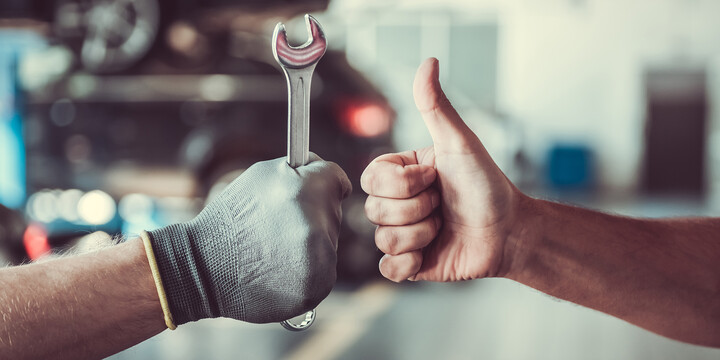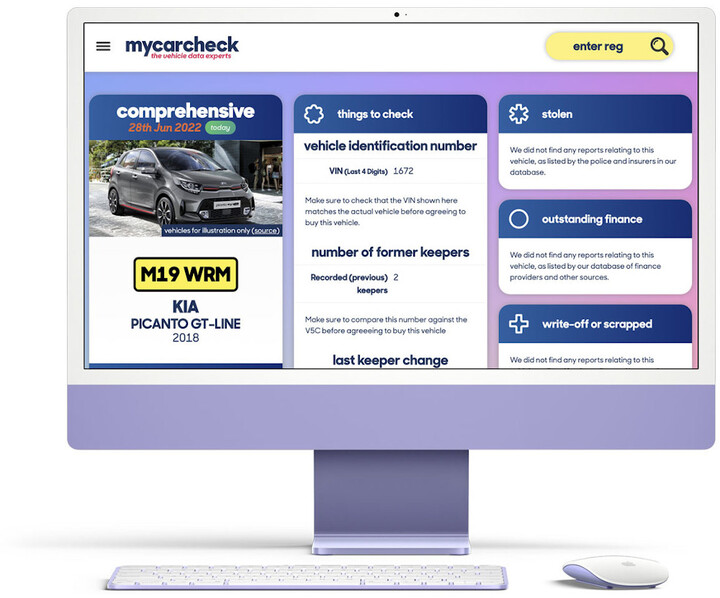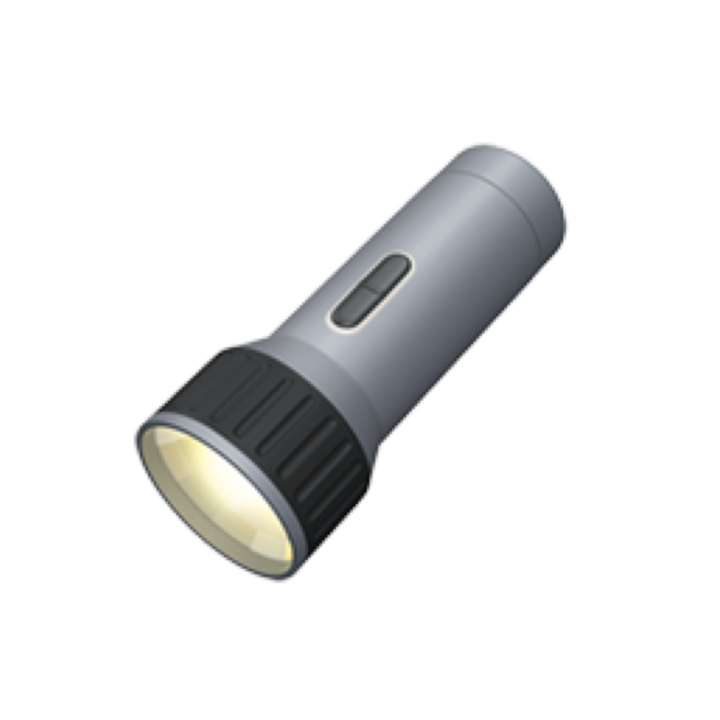
things to check when inspecting a car
FREE Car History Check
See MOT history, valuations, detailed specs and more… AND upgrade to see if any vehicle has been stolen, has finance or has been written off from just £4.99
When buying a used car it is very important to inspect the vehicle to make sure it drives and all the components work correctly.
Vehicle Accident Damage & Body Condition Inspection
Checking the condition of a car’s bodywork can often be the most daunting. Cars do receive the odd bumps and scrapes during their lives and if repaired properly these aren't necessarily an issue. But finding what may have been repaired and asking the right questions can help unpick a vehicle’s history.
We will start with some quick do's and dont's.
- Do - ensure the car is viewed in decent light.
- Do - try and inspect a vehicle when it is clean and dry.
- Don’t rush the inspection - any seller with nothing to hide shouldn’t mind. Don’t be afraid to get a little grubby: lift the boot and bonnet, crawl underneath and even inspect beneath the carpeting.
So, what should you be looking for?
First impressions are important. So rather than thinking a car looks wonderfully shiny, ask yourself if this is right on an older car? Has it simply been waxed beautifully or has it received new paint, and if so, why?
Look along the sides of a car. Does the swage line - the contour running along the length of the car - look as it should with all the panels lining up? Check the bonnet and boot too: do the shut lines match on each side? If anything is out of alignment, it can mean a vehicle has received some poor repair work.
Even if a car has been repaired well, look for mismatches in the colours. Good body shops often blend-in newly painted areas mid-panel so check for this too. The old trick of running your fingers down the length of a car also holds merit: paint applied at different times may have a slightly different feel.
Remember to inspect the edges of the panels. This is where they will have been masked-off for spray work and sometimes it is possible to see the edges of the new paint. Pay particular attention to the bonnet, boot and door edges. And with them all opened, look at the rubber sealing strips, both to see if there is any overspray from repainting or if they have been used as a masking edge. The same goes for window surrounds and even around the fuel filler cap.
With the bonnet and boot lifted it is often possible to see where a car has been welded together in the factory. But do all the welds, bolts and seams look the same on each side of the car and do some areas appear freshly painted on one side but not the other? If possible, lift any door rubbers and carpeting to inspect the seams and floor for damage or repair work.
Front and rear end bumps are common so lift the boot floor carpet and check where the spare wheel sits. Is it all clean and straight? Is there any water in there which could be a sign of something misaligned. In the engine compartment, look at the inner wings, front panel and even the radiator for telltale signs of damage.
Lastly, be prepared to look underneath. Some shoddy repairers won’t do a proper job where they think people won’t see.
Engine Compartment Inspection
The engine is the heart of any car and while it isn’t possible to see inside to view its condition, there are some checks you can do. These will help you gauge how well it has been maintained and perhaps offer clues to something more serious. While new engines are often buried under a plastic cowl with the manufacturer’s logo on, there should still be some of the plumbing and belts visible. It is good to see a car started up from cold too, so do ask for it not to have been run before you view it. (You’ll know if it was because the bonnet will be warm!)
Before starting the engine
To be on the safe side, do ensure the keys are not in the ignition (and for those vehicles with a start button, it is safest for the keys to remain outside the car to prevent the engine from being started). Now lift the bonnet and do a visual check of the overall condition, including the underside of the bonnet as it can show marks from escaped fluids or burns from electrical issues.
Start by looking for leaks, worn belts or damaged hoses. Belts should be taut and show no signs of cracking or fraying. Check that all the pulleys have belts on too: these drive key items such as the power steering pump, air conditioning compressor, and alternator.
Check all the hoses you can see, especially those lower down which might need a torch. Look for any faults such as leaks, splits or missing clamps. Coolant hoses shouldn’t be squashy - they should be firm indicating their structure is sound and that there is pressure in the cooling system.
Wiring should be secured neatly within harnesses to keep it safe but look for signs of damage or tampering. Look at the battery too: there shouldn’t be much corrosion on the terminals and if you are lucky, there might be a date sticker to indicate how old it is.
Many of the checks you can do are for escaping fluids. These could be oil, brake, clutch or coolant. Older cars with carburettors may have a faint smell of petrol but newer cars certainly shouldn’t. There may be a slight smell of oil too but again, this shouldn’t be overpowering. See our section on Oil and Fluids. Beware when the engine has been steam cleaned, could this have washed away the mess left from a serious leak?
Start the car
Now start the engine and check it fires-up quickly on the first turn of the key (or push of the button). Do another visual check. First, note the exhaust and look for any excessive smoke. Blue-ish smoke can indicate it is burning oil (so the engine could, for example, have worn piston rings). There may be some white-ish vapour as condensation from the exhaust pipe evaporates but continued, excessive white smoke may indicate a head gasket problem. (With the engine turned off, a quick check for any white emulsion gunk beneath the oil filler cap would also point to a head gasket issue.)
Around the engine bay, there should be no signs of escaping fluids (remember to check beneath the car), no smell of exhaust gasses (unless the wind is blowing it from the exhaust tailpipe towards you) and no knocks or rattles. Strange sounds could be indicating loose components, worn parts, poor adjustment or poor internal lubrication.
Most engines are a little noisier when cold - especially diesel - but should quieten down reasonably quickly as they warm.
Other considerations
Things you can’t see but should ask about are filters for oil, fuel, air, and pollen. All should have been replaced in line with the service schedule. Extremely important is knowing if the vehicle has a cambelt (rather than a chain) and whether this has been replaced according to the manufacturer’s recommendation - or if it is due soon (as it can be costly).
Vehicle Electrical Controls Inspection
New cars are being fitted with increasing numbers of electrical items. These range from the parts which enable the main operation of the vehicle to luxury features such as powered seat adjustments and even tailgate motors. It is worth stepping through each of these to ensure they work as they should - especially with any vehicle sold ‘as seen’ - as they can be costly to fix and inconvenient if faulty.
First, check for any warning lights on the dashboard. If the engine management warning symbol is illuminated it is essential to understand why - before driving anywhere. It is often triggered by a failed sensor somewhere but could indicate something more serious. Many breakdown services and garages have diagnostic systems to help understand what the problem is.
Next, ensure all the controls work as they should. Check everything from the windscreen wipers and washers to the audio and navigation system. This should include a short drive to test the power steering. And remember even the accelerator pedal on a new car is a variable switch rather than a lever and cable. Many new cars have electronic parking brakes too.
Finally, work your way around the car systematically. Not only should you check each electric window motor but each switch; there will be one on each door plus a full set for the driver. Check seat motors, heated seats, sunroofs and even the remote release for the fuel filler cap.
Car Suspension Inspection
Ensuring a car’s suspension is in good working order isn’t just for comfort but is a matter of safety. Correctly maintained suspension ensures the car will go around corners properly and impacts braking ability too. For a full inspection, you should be prepared to jack the vehicle up (and use axle stands for safety). However, there are some visual checks you can do and a drive is a useful way to help identify certain faults.
But before you go near the vehicle, if it is more than three years old, check the previous MOT report. The MOT inspection is thorough and while it won’t tell you what might have failed since the test, it is a good starting point. It will allow you to see if there were any warnings to indicate components that are wearing out. You can view this either via https://www.check-mot.service.gov.uk/ or as part of a vehicle checking service such as My Car Check. Here are two examples; they are descriptive and can be useful for discussions with the vendor.
- Nearside Track rod end ball joint has slight play (2.2.B.1f)
- Nearside Front Axle kingpin has slight play in pin and/or bush (2.5.A.3a)
Visual checks
First, look at the car from a few paces away. Does it sit level on the road? Using your hand as a rough gauge, see if the gap between the wheel arches and wheels is the same on each side. Compare both the front wheels together and then the rear ones together (as body styling often means the front are rear differ from each other).
Press down on each corner of the car and check that it returns to its position within one bounce. Choose a place on each of the wings as bonnet or boot panels are weaker and more likely to deform.
Then, torch in hand, look from behind the vehicle and beneath the sills at the rear suspension. Inspect the assemblies for corrosion, missing or broken rubber bushes, loose bolts, broken springs, leaking shock absorbers and to see if there is any debris trapped. Using a small mirror or taking a photo using a mobile phone with a flash can help.
Look for the same faults at the front too. Turn the steering to its maximum lock one way and then the other to gain the best view behind each wheel. Check the steering linkages too, looking for play or wear in the track rod ends. And look at the states of any rubber boots and gaiters which prevent damage from dust and grit.
One of the straightforward checks to confirm the car’s suspension is aligned properly is to look at all of the tyres. Do any have a noticeable increase in wear on the inner or outer edges?
Lastly, look at the top of the front suspension mounts from under the bonnet to check for corrosion, loose bolts or even cracks in the inner wings.
Behind the wheel
On the road, the car should be stable and the ride reasonably supple. Do make allowances for sportier models with firm suspension and very low profile tyres as these will have a much harder ride. The car shouldn’t markedly lift its nose on acceleration, dive under moderate braking or roll too much in a corner. Nor should there be any audible clunks, squeaks or rattles from beneath.
Do look for a speed hump or gentle undulation in the road. You don’t have to drive quickly or aggressively over it - and the seller may not be happy if you do - but listen for any unusual sounds. Note how the car handles too. Is there any swaying or are there second and third bounces afterwards? This could indicate worn-out components such as dampers which need replacing.
Ideally not on the public highway, drive along slowly and steer fully from left to right a couple of times to ensure there are no strange sounds. Does it behave the same in each direction? When on lock, are there any sounds that could indicate worn CV joints (which transmit the drive to the wheels on front-wheel-drive cars)?
Due to the critical nature of a car’s suspension, if any aspect doesn’t appear or feel right, it should be checked by a professional.
Car Steering Inspection
Like all the suspension components, those parts needed to steer the car are also best viewed from underneath. However, with the steering wheel turned to its extreme one way - and then the other - it is possible to see much of the mechanism behind the front wheels.
Check the general condition, looking for worn rubber bushes, serious corrosion, and even debris trapped. Also, check the condition of the rubber gaiters which prevent dirt from entering the steering box.
If the car is more than three years old, check the previous MOT report. The MOT inspection is detailed and while some items could have worn out since the test, it is a good starting point. You can view this either via https://www.check-mot.service.gov.uk/ or as part of a vehicle checking service such as My Car Check.
The front tyres are good indicators to show whether the steering is adjusted properly. Excessive toe-in (where the front wheels point slightly inward at the front) or toe-out (where they point away from each other) will put uneven wear on the tyres. Excessive toe-in will cause wear on the outer edges of the front tyres; toe-out can wear their inner edges.
Behind the wheel, check to see if the car pulls to one side. Note that most roads have a gentle camber - a slope from the middle to the gutter to allow water to drain - so unless you can find some flat road a car may pull ever so slightly to the left here in the UK.
Test too that when driving straight ahead the steering wheel is centred too. If not, it could mean the track rod linkages aren’t properly adjusted or one of the wheels has taken a knock, distorting the geometry.
Car Brakes Inspection
When you think about it, a car’s brakes aren’t just extremely important: they are astonishing in their ability to bring your car - usually between one and two tonnes in weight - to a swift halt. So while they have parts which are considered consumable items because they wear down, it still makes sense to check them on any used car you are evaluating. This is both for your safety and to understand the upcoming bills should parts need replacing.
New cars will have disc brakes on the front. The rear brakes could be disc, drum or both.
Safety first
If you are unsure about any aspects of vehicle inspection and safety, you should use one of the recognised inspection services.
And should you feel uncomfortable with the condition of any part car you are looking to purchase - especially with something as critical as the brakes - simply do not drive it and do make the seller aware.
Inspection
Most modern cars have a sensor to detect when brake pads are worn low but it is important not to rely on this. For a full inspection, you will need to remove the wheels to see all of the discs plus the inner and outer pads. If the car has drum brakes at the rear, these use internal, curved pads called shoes and can’t be properly inspected without removal of the wheel and the drum itself.
However, with the help of a torch, you should be able to get an indication of the general condition and state of wear. And it is usually easier with cars fitted with alloy wheels because their designs tend to have larger gaps to see through.
The discs shouldn’t have any cracks, excess corrosion or visible distortion. The corrosion can often build up as a rusty outer lip; distortion can be shown by an uneven wear pattern on the disc. The pads should be changed when they have between 2mm and 3mm left.
Look at the brake pipes beneath the car for signs of damage, corrosion or leaks. With the front wheels turned, you should be able to see the flexible brake hoses which connect to the calliper at the back of the wheels. Look for cracks, splits and any leakage of brake fluid at the joints.
Electronics play a huge part in modern car braking systems so do check the dashboard for any warning lights for safety features such as ABS.
Finally, check the fluid in the header tank under the bonnet.
Driving
When looking to buy a used car you should aim to have a test drive if possible. Remember there are other road users so it can be dangerous to brake seemingly at random. But as part of your road test, ensure there are no judders or squeals when braking. The pedal action should be firm, the car should brake in a straight line and there shouldn’t be any fade in the effectiveness during longer periods of braking.
Vehicle Engine Number Inspection
A car’s engine number is stamped on the side of its engine block. The location varies depending on the particular engine so you may need to refer to the handbook or manufacturer. To confirm the car has its original engine, also look at the vehicle identification number (VIN) and the last six digits should match.
While there are some perfectly valid reasons why an engine might have been replaced, knowing it isn’t the original one will allow you to ask the right questions of the seller. And using a vehicle checking service such as My Car Check will help uncover any undesirable past which may have led to an engine swap, such as whether the vehicle has been written off due to a crash.
Chassis Number
Why you should check the VIN number, before buying a used car
A car’s engine number is stamped on the side of its engine block. The location varies depending on the particular engine so you may need to refer to the handbook or manufacturer. To confirm the car has its original engine, also look at the vehicle identification number (VIN) and the last six digits should match.
While there are some perfectly valid reasons why an engine might have been replaced, knowing it isn’t the original one will allow you to ask the right questions of the seller. And using a vehicle checking service such as My Car Check will help uncover any undesirable past which may have led to an engine swap, such as whether the vehicle has been written off due to a crash.














